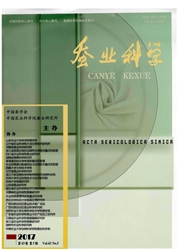

 中文摘要:
中文摘要:
解明家蚕微孢子虫(Nosema bombycis,Nb)入侵宿主细胞的相关因素,有助于深入研究Nb对家蚕的侵染机制。利用激光共聚焦显微镜观察Nh孢子接种粉纹夜蛾(Trichoplusia ni,Tn)培养细胞48h后孢子的分布状态和培养细胞的生长情况,并对接种Nb孢子后的Tn培养细胞培养物总蛋白进行SDS-PAGE分析,证实经0.2mol/LKOH预处理的Nb孢子可以被Tn培养细胞所吞噬。对Nb孢子孢壁蛋白的SDS—PAGE分析显示,Nb孢子经KOH预处理后,大小为80kD和12kD的孢壁蛋白带缺失或明显减弱,30kD的孢壁蛋白带丰度降低。推测KOH预处理使Nb孢子部分孢壁蛋白被分解(部分或完全)或使蛋白结构发生变化,由此影响了Nb孢子与Tn培养细胞的相互作用关系,有利于Tn培养细胞对Nb孢子的吞噬。
 英文摘要:
英文摘要:
Clarifying the related factors of invasion into host cell would contribute to in-depth study of the infection mechanisms of Nosema bombycis (Nb). In this study, we used a laser scanning confocal microscope to observe the distribution of Nb spores and the growth of Trichoplusia ni (Tn) cultured ceils at 48 h after inoculation with Nb spores, and employed SDS-PAGE to examine total proteins in Tn cell cultures after inoculating Nb spores. The results proved that the Nb spores pretreated with 0.2 mol/L KOH could be phagocytosed by Tn cell cultures. SDS-PAGE analysis on spore wall proteins of Nb spores indicated that KOH treatment not only resulted in the absence and reduction of spore wall protein bands of 80 kD and 12 kD but also led to the decrease of 30 kD spore wall protein abundance. According to the above results, we suggested that spore wall proteins were decomposed (partially or totally) or protein structures were changed after KOH treatment, thus affecting the interactive relationship between Nb spores and Tn cultured cells and facilitating the phagocytosis of Tn cultured cells to Nb spores.
 同期刊论文项目
同期刊论文项目
 同项目期刊论文
同项目期刊论文
 期刊信息
期刊信息
